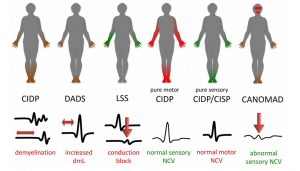What Causes CIDP and how will I be diagnosed by my Doctor?
Pattern of Symptoms in Chronic Conditions

Although sometimes a trigger is apparent, and in contrast to GBS, most patients with CIDP cannot identify a preceding viral or bacterial infection. GBS normally progresses over 2-4 weeks, then plateaus, improves over several months and does not usually recur. CIDP has ongoing symptoms for over 8 weeks and usually does not improve unless ongoing treatment is given.
How is CIDP Diagnosed?
CIDP can be difficult to diagnose as there is no single, conclusive diagnostic test for it. The symptoms are often vague and can be produced by a number of different conditions.
Therefore, a long period of time may elapse before a diagnosis of CIDP is made. A diagnosis of CIDP requires the following:
• weakness of at least two limbs
• complete or partial loss of tendon reflexes
• progression or relapse eight weeks or more after initial disease onset
• evidence of myelin damage in the peripheral nerves from nerve conduction studies
A diagnosis of CIDP is usually made on clinical grounds but with evidence from:
• nerve conduction studies
• lumbar puncture
• MRI scan
• nerve biopsy
• ruling out other diseases that can cause demyelinating neuropathy
• family history to completely rule out an inherited neuropathy
• contact with possible toxins or drugs that could cause neuropathy
• other conditions – diabetes, alcohol dependency, arthritis or hepatitis
Nerve Tests
In hospital, two tests may be carried out to see how well your nerves are working. These are:
Electromyogram (EMG) – tiny needles are inserted into your muscles and electrical recordings are taken to see how they react when nearby nerves are activated.
Nerve Conduction Studies – small discs (electrodes) are stuck on your skin and minor electric shocks are used to activate the nerves and measure how quickly these signals travel along them.
In people with GBS, these tests will usually show that signals are not travelling along the nerves properly.
Lumbar Puncture
The lumbar puncture is a procedure to remove some fluid from around the spinal cord (the nerves running up the spine) which involves lying on one side and having a needle inserted into the base of the spine under local anaesthetic.
The sample of fluid will be checked for signs of problems that can cause similar symptoms to GBS, such as an infection.
Occasionally the diagnosis can be delayed for a few days while they are checking the results, and your doctor may start the treatment just to be on the safe side.

